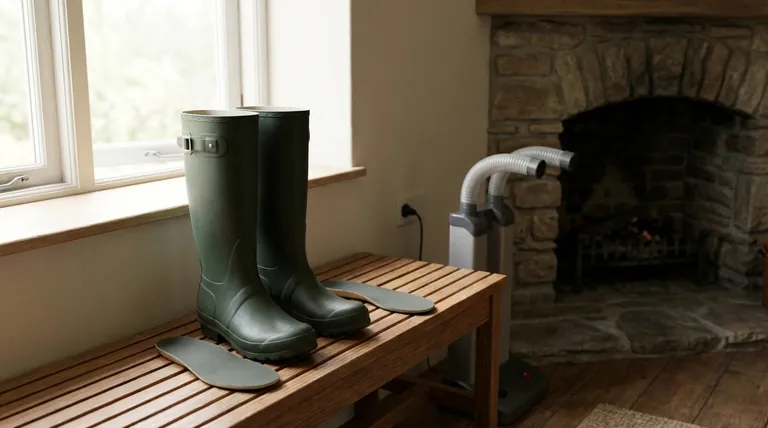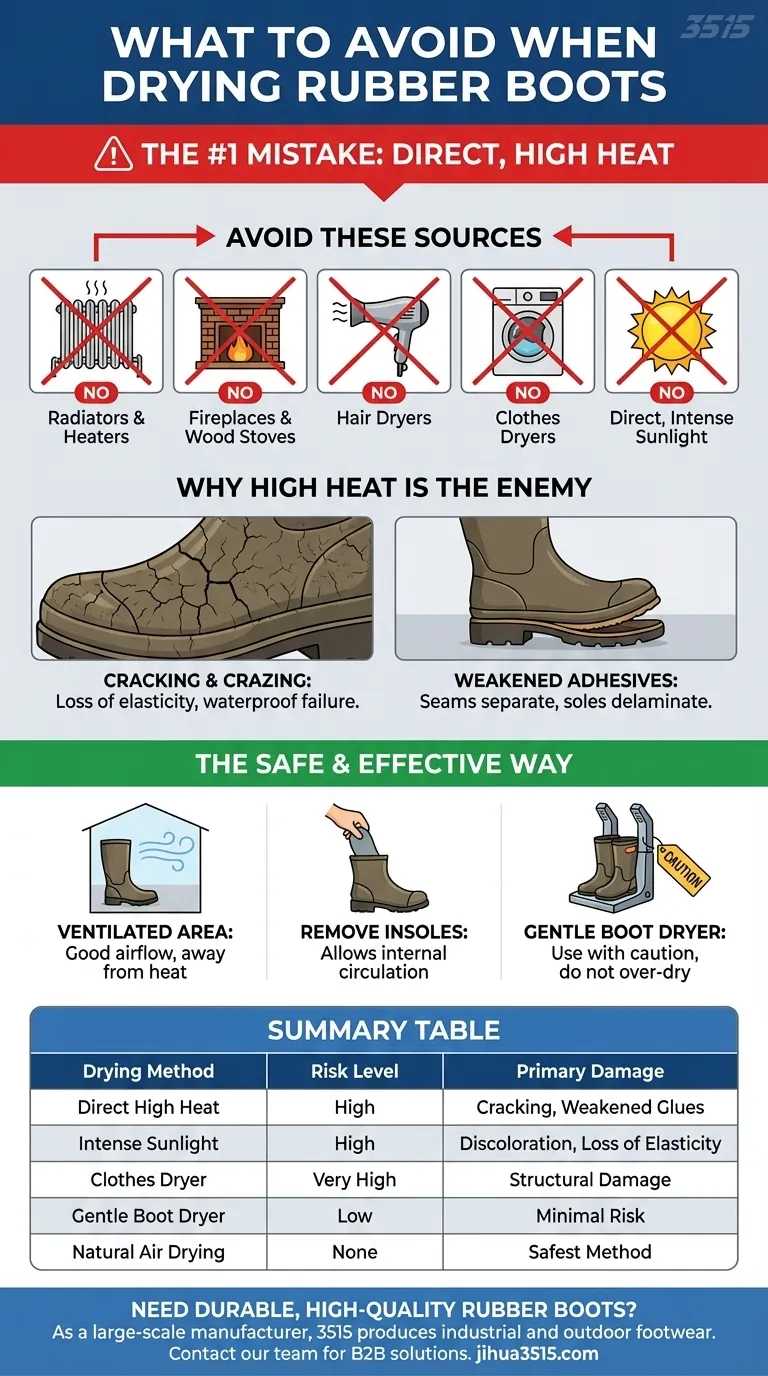The single biggest mistake you can make when drying rubber boots is exposing them to direct, high heat. Sources like fireplaces, radiators, hair dryers, or even intense, direct sunlight will shorten the life of your boots and compromise their primary function: keeping you dry.
The core principle is simple: rapid, high-heat drying methods cause irreversible damage. The key to preserving your rubber boots is to prioritize slow, gentle air circulation over speed.

The Primary Rule: Avoid Direct Heat
The most critical factor in preserving your rubber boots is how you dry them after use. The temptation to speed up the process with a convenient heat source is the fastest way to ruin them.
What is "Direct Heat"?
Any source that applies concentrated, high temperatures should be avoided. This includes:
- Radiators and Heaters: Placing boots on or directly next to these devices is a common mistake.
- Fireplaces or Wood Stoves: The intense radiant heat will quickly damage the rubber.
- Hair Dryers: The focused blast of hot air can cause localized damage and weaken seams.
- Clothes Dryers: Never put rubber boots in a clothes dryer; the combination of heat and tumbling is destructive.
- Direct, Intense Sunlight: Leaving boots to bake on a hot day can cause the rubber to become brittle and discolored.
Why High Heat is the Enemy of Rubber
Understanding the "why" helps reinforce the correct habit. High heat attacks the material composition of your boots in several ways, leading to catastrophic failure.
It Causes Cracking and Crazing
Rubber maintains its flexibility and waterproof properties thanks to plasticizers and natural oils within the material. High heat effectively "cooks" these compounds out of the rubber.
This loss of moisture and elasticity leads to cracking and crazing—a network of fine cracks on the surface. These fissures compromise the boot's waterproof integrity, rendering it useless.
It Weakens Adhesives
Modern boots are assembled with powerful adhesives that bond the soles to the uppers and seal the seams.
High heat can soften and weaken these glues, causing seams to separate or soles to delaminate. This is a structural failure that is often impossible to repair properly.
The Safe and Effective Way to Dry Your Boots
Proper drying isn't complicated; it just requires patience. The goal is to encourage evaporation through air circulation, not forceful heating.
Find a Well-Ventilated Area
Choose a spot with good airflow, such as a mudroom, garage, or covered porch. Keep the boots away from direct sunlight and heat sources.
Remove the Insoles
If your boots are thoroughly soaked, always remove the insoles. This opens up the interior of the boot, allowing air to circulate and preventing the growth of mold and mildew.
Use a Boot Dryer (With Caution)
A specialized boot dryer is the one exception to the "no heat" rule. These devices are designed to use gentle, slightly warm air circulated by a fan. They are far safer than a radiator or hair dryer.
Even with a proper boot dryer, use it cautiously. Don't leave boots on it for an excessive amount of time, as this can still over-dry the material.
Making the Right Choice for Your Boots
Your approach should match your priority. By understanding the core principles, you can ensure your boots last for seasons to come.
- If your primary focus is maximum longevity: Always air-dry your boots naturally in a well-ventilated space, with the insoles removed.
- If your primary focus is faster, safe drying: A dedicated boot dryer that uses gently warmed, circulated air is the only acceptable mechanical option.
- If your primary focus is restoring shine or conditioning: Gently rub a few drops of olive oil onto the surface with a soft cloth to replenish the rubber.
Ultimately, protecting your investment comes down to avoiding the temptation of a quick fix.
Summary Table:
| Drying Method | Risk Level | Primary Damage |
|---|---|---|
| Direct High Heat (Radiator, Hair Dryer) | High | Cracking, Weakened Glues, Brittleness |
| Intense Sunlight | High | Discoloration, Loss of Elasticity |
| Clothes Dryer | Very High | Structural Damage from Heat & Tumbling |
| Gentle Boot Dryer | Low | Minimal Risk if Used Correctly |
| Natural Air Drying | None | Safest Method for Longevity |
Need Durable, High-Quality Rubber Boots That Last?
As a large-scale manufacturer, 3515 produces a comprehensive range of industrial and outdoor footwear for distributors, brand owners, and bulk clients. Our expertise ensures every pair is built with durable materials and construction methods designed to withstand the elements.
Let us help you provide superior footwear to your customers.
Contact our team today to discuss your needs and explore our full product catalog.
Visual Guide

Related Products
- Safety Footwear Wholesale Manufacturer for Custom OEM/ODM Production
- Premium Flame-Retardant Waterproof Safety Boots and Shoes
- Factory-Direct Wholesale Canvas Boots with High-Traction Rubber Soles
- Wholesale Waterproof Tactical Boots Custom Suede & High-Traction Soles
- Premium Wholesale Tactical Style Safety Shoes Boots with Quick Lacing
People Also Ask
- Do snake bite boots work? Your Ultimate Guide to Effective Snake Bite Protection
- Is safety-toe as good as steel toe? Choose the Right Protection for Your Job
- What are OSHA approved shoes? Understanding the Correct Standards for Workplace Safety
- What are the differences between steel toe, composite toe, and alloy toe Wellington boots? Choose the Right Safety Toe for Your Job
- What do heavy duty boots do? Protect Your Feet in Demanding Work Environments



















